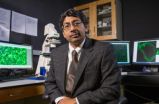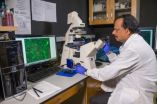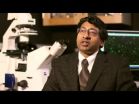(Press-News.org) One factor that makes glioblastoma cancers so difficult to treat is that malignant cells from the tumors spread throughout the brain by following nerve fibers and blood vessels to invade new locations. Now, researchers have learned to hijack this migratory mechanism, turning it against the cancer by using a film of nanofibers thinner than human hair to lure tumor cells away.
Instead of invading new areas, the migrating cells latch onto the specially-designed nanofibers and follow them to a location – potentially outside the brain – where they can be captured and killed. Using this technique, researchers can partially move tumors from inoperable locations to more accessible ones. Though it won't eliminate the cancer, the new technique reduced the size of brain tumors in animal models, suggesting that this form of brain cancer might one day be treated more like a chronic disease.
"We have designed a polymer thin film nanofiber that mimics the structure of nerves and blood vessels that brain tumor cells normally use to invade other parts of the brain," explained Ravi Bellamkonda, lead investigator and chair of the Wallace H. Coulter Department of Biomedical Engineering at Georgia Tech and Emory University. "The cancer cells normally latch onto these natural structures and ride them like a monorail to other parts of the brain. By providing an attractive alternative fiber, we can efficiently move the tumors along a different path to a destination that we choose."
Details of the technique were reported February 16 in the journal Nature Materials. The research was supported by the National Cancer Institute (NCI), part of the National Institutes of Health; by Atlanta-based Ian's Friends Foundation, and by the Georgia Research Alliance. In addition to the Coulter Department of Biomedical Engineering, the research team included Children's Healthcare of Atlanta and Emory University.
Treating the Glioblastoma multiforme cancer, also known as GBM, is difficult because the aggressive and invasive cancer often develops in parts of the brain where surgeons are reluctant to operate. Even if the primary tumor can be removed, however, it has often spread to other locations before being diagnosed.
New drugs are being developed to attack GBM, but the Atlanta-based researchers decided to take a more engineering approach. Anjana Jain, who is the first author of this GBM study, is now an assistant professor in the Department of Biomedical Engineering at Worcester Polytechnic Institute in Massachusetts. As a Georgia Tech graduate student, Jain worked on biomaterials for spinal cord regeneration. Then, as a postdoctoral fellow in the Bellamkonda lab, she saw the opportunity to apply her graduate work to develop potential new treatment modalities for GBM.
"The signaling pathways we were trying to activate to repair the spinal cord were the same pathways researchers would like to inactivate for glioblastomas," said Jain. "Moving into cancer applications was a natural progression, one that held great interest because of the human toll of the disease."
Tumor cells typically invade healthy tissue by secreting enzymes that allow the invasion to take place, she explained. That activity requires a significant amount of energy from the cancer cells.
"Our idea was to give the tumor cells a path of least resistance, one that resembles the natural structures in the brain, but is attractive because it does not require the cancer cells to expend any more energy," she explained.
Experimentally, the researchers created fibers made from polycaprolactone (PCL) polymer surrounded by a polyurethane carrier. The fibers, whose surface simulates the contours of nerves and blood vessels that the cancer cells normally follow, were implanted into the brains of rats in which a human GBM tumor was growing. The fibers, just half the diameter of a human hair, served as tumor guides, leading the migrating cells to a "tumor collector" gel containing the drug cyclopamine, which is toxic to cancer cells. For comparison, the researchers also implanted fibers containing no PCL or an untextured PCL film in other rat brains, and left some rats untreated. The tumor collector gel was located physically outside the brain.
After 18 days, the researchers found that compared to other rats, tumor sizes were substantially reduced in animals that had received the PCL nanofiber implants near the tumors. Tumor cells had moved the entire length of all fibers into the collector gel outside the brain.
While eradicating a cancer would always be the ideal treatment, Bellamkonda said, the new technique might be able to control the growth of inoperable cancers, allowing patients to live normal lives despite the disease.
VIDEO:
One factor that makes glioblastoma cancers so difficult to treat is that malignant cells from the tumors spread throughout the brain by following nerve fibers and blood vessels to invade...
Click here for more information.
"If we can provide cancer an escape valve of these fibers, that may provide a way of maintaining slow-growing tumors such that, while they may be inoperable, people could live with the cancers because they are not growing," he said. "Perhaps with ideas like this, we may be able to live with cancer just as we live with diabetes or high blood pressure."
Before the technique can be used in humans, however, it will have to undergo extensive testing and be approved by the FDA – a process that can take as much as ten years. Among the next steps are to evaluate the technique with other forms of brain cancer, and other types of cancer that can be difficult to remove.
Treating brain cancer with nanofibers could be preferable to existing drug and radiation techniques, Bellamkonda said.
"One attraction about the approach is that it is purely a device," he explained. "There are no drugs entering the blood stream and circulating in the brain to harm healthy cells. Treating these cancers with minimally-invasive films could be a lot less dangerous than deploying pharmaceutical chemicals."
Seed funding for early research to verify the potential for the technique was sponsored by Ian's Friends Foundation, an Atlanta-based organization that supports research into childhood brain cancers.
"We couldn't be more thrilled with the progress that Georgia Tech and Professor Bellamkonda's lab have made in helping find a solution for children with both inoperable brain tumors and for those suffering with tumors in more invasive areas," said Phil Yagoda, one of the organization's founders. "With this research team's dedication and vision, this exciting and exceptional work is now closer to reality. By enabling the movement of an inoperable tumor to an operable spot, this work could give hope to all the children and parents of those children fighting their greatest fight, the battle for their lives."
INFORMATION:
In addition to those already mentioned, the research team included Barunashish Brahma from the Department of Neurosurgery at Children's Healthcare of Atlanta; Tobey MacDonald from the Department of Pediatrics at Emory University School of Medicine, and Martha Betancur, Gaurangkuma Patel, Chandra Valmikinathan, Vivek Mukhatyar, Ajit Vakharia and S. Balakrishna Pai from the Wallace H. Coulter Department of Biomedical Engineering at Georgia Tech and Emory University.
This research was supported by the National Cancer Institute of the National Institutes of Health (NIH) through EUREKA award number R01-CA153229. Any conclusions or opinions are those of the authors and do not necessarily represent the official views of the NIH.
CITATION: Anjana Jain, et al., "Guiding intracortical brain tumour cells to an extracortical cytotoxic hydrogel using aligned polymeric nanofibres," (Nature Materials, 2014). (http://dx.doi.org/10.1038/nmat3878).
Researchers hijack cancer migration mechanism to 'move' brain tumors
2014-02-17
ELSE PRESS RELEASES FROM THIS DATE:
U of M study finds fertilization destabilizes global grassland ecosystems
2014-02-17
A new study led by University of Minnesota researchers demonstrates that fertilization of natural grasslands -- either intentionally or unintentionally as a side effect of global farming and industry -- is having a destabilizing effect on global grassland ecosystems. Using a network of natural grassland research sites around the world called the Nutrient Network, the study represents the first time such a large experiment has been conducted using naturally occurring sites.
Led by Yann Hautier, a Marie Curie Fellow associated with both the Department of Ecology, Evolution, ...
New study shows growing opposition to animal tests
2014-02-17
Chicago — Americans' moral opposition to animal testing
has grown significantly since 2001, according to a new study presented today at the annual
meeting of the prestigious American Association for the Advancement of Science (AAAS) in
Chicago. Researchers from PETA and Western Governors University examined data collected
in independent surveys by the Gallup organization from 2001 to 2013, in which approximately
1,000 American adults each year were asked whether they found "medical testing on animals" to be
"morally acceptable" or "morally wrong."
The researchers ...
Mount Hood study suggests volcano eruptibility is rare
2014-02-17
Forecasts of when a volcano is ready to erupt could be a little closer thanks to work by
geologists at the University of California, Davis, and Oregon State University published online Feb.
16 in the journal Nature.
For an eruption to occur, the magma, or molten rock under the volcano must be sufficiently
mobile to erupt.
"The question is, what percentage of time is the magma in an eruptible state?" said Kari
Cooper, associate professor in the Department of Earth and Planetary Sciences at UC Davis and lead
author on the paper.
"People think about there being ...
Volcanoes, including Mt. Hood, can go from dormant to active quickly
2014-02-17
CORVALLIS, Ore. – A new study suggests that the magma sitting 4-5 kilometers beneath the surface of Oregon's Mount Hood has been stored in near-solid conditions for thousands of years, but that the time it takes to liquefy and potentially erupt is surprisingly short – perhaps as little as a couple of months.
The key, scientists say, is to elevate the temperature of the rock to more than 750 degrees Celsius, which can happen when hot magma from deep within the Earth's crust rises to the surface. It is the mixing of the two types of magma that triggered Mount Hood's last ...
River samples shed light on the spread of potential 'superbugs'
2014-02-17
The spread of antibiotic-resistance to one of the most pristine locations in Asia is linked to the annual human pilgrimages to the region, new research has shown.
Experts from Newcastle University, UK, and the Indian Institute of Technology in Delhi (IIT-Delhi), sampled water and sediments at seven sites along the Upper Ganges River, in the foothills of the Himalayas.
They found that in May and June, when hundreds of thousands of visitors travel to Rishikesh and Haridwar to visit sacred sites, levels of resistance genes that lead to "superbugs" were found to be about ...
New blood cells fight brain inflammation
2014-02-17
Hyperactivity of our immune system can cause a state of chronic inflammation. If chronic, the inflammation will affect our body and result in disease. In the devastating disease multiple sclerosis, hyperactivity of immune cells called T-cells induce chronic inflammation and degeneration of the brain. Researchers at BRIC, the University of Copenhagen, have identified a new type of regulatory blood cells that can combat such hyperactive T-cells in blood from patients with multiple sclerosis. By stimulating the regulatory blood cells, the researchers significantly decreased ...
Iowa State University's Wintersteen talks partnerships at national science meeting
2014-02-17
AMES, Iowa – Wendy Wintersteen, dean of Iowa State University's College of Agriculture and Life Sciences, spoke on Sunday of the importance of public-private partnerships in strengthening global food security during the annual meeting of the American Association for the Advancement of Science in Chicago.
During her talk, part of a panel on research and development for sustainable agriculture and food security, Wintersteen stressed the importance of partnerships in providing the innovation necessary to meet global challenges.
She said climate change, pests, plant ...
Scientists call for new stewardship of the deep ocean: Earth's last frontier
2014-02-17
The deep ocean, the largest domain for life on earth, is also its least explored environment. Humans are now encroaching more vigorously than ever into the ocean's deep regions, exploiting the deep's resources and placing its wealth of vibrant habitats and natural services for the planet at risk.
Lisa Levin, a biological oceanographer at Scripps Institution of Oceanography at UC San Diego, believes the vital functions provided by the deep sea—from carbon sequestration to nurturing fish stocks—are key to the health of the planet. As humans ramp up exploitation of deep-sea ...
Researchers rejuvenate stem cell population from elderly mice, enabling muscle recovery
2014-02-17
STANFORD, Calif. — Researchers at the Stanford University School of Medicine have pinpointed why normal aging is accompanied by a diminished ability to regain strength and mobility after muscle injury: Over time, stem cells within muscle tissues dedicated to repairing damage become less able to generate new muscle fibers and struggle to self-renew.
"In the past, it's been thought that muscle stem cells themselves don't change with age, and that any loss of function is primarily due to external factors in the cells' environment," said Helen Blau, PhD, the Donald and Delia ...
New 'pomegranate-inspired' design solves problems for lithium-ion batteries
2014-02-17
An electrode designed like a pomegranate – with silicon nanoparticles clustered like seeds in a tough carbon rind – overcomes several remaining obstacles to using silicon for a new generation of lithium-ion batteries, say its inventors at Stanford University and the Department of Energy's SLAC National Accelerator Laboratory.
"While a couple of challenges remain, this design brings us closer to using silicon anodes in smaller, lighter and more powerful batteries for products like cell phones, tablets and electric cars," said Yi Cui, an associate professor at Stanford ...





